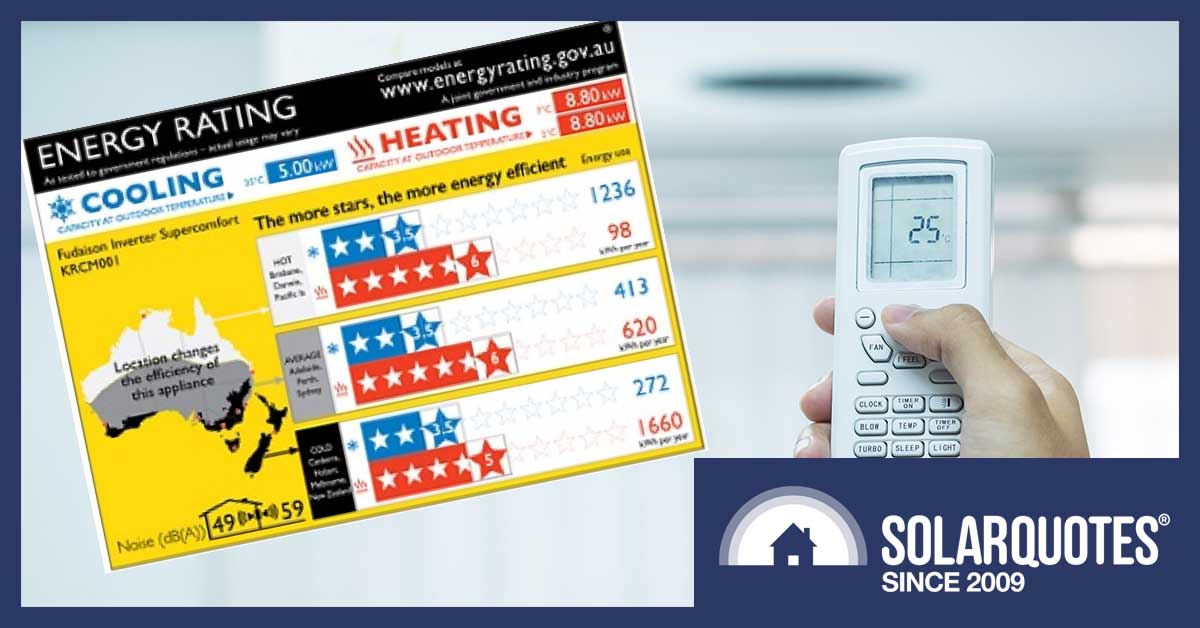
New aircon energy rating labels! Are you excited? You should be…
The most energy-efficient and cost-effective way to heat your home is to use your reverse-cycle air conditioner. Even the least efficient aircon uses far less energy than electric resistance heating. But buying the least efficient air conditioner is a bad idea. You’ll be better off with a highly efficient one — or at least the most efficient one that doesn’t cost an arm and a leg.
To help those looking for an air conditioner that won’t guzzle electricity, the government has introduced improved energy efficiency labels. Because an air-conditioner’s efficiency depends on the local climate, they divide Australia into three zones — Hot, Average, and Cold — with New Zealand included in the cold zone.
You can see the new labels on some air conditioners in stores now, but the old ones may not all be gone until March 2025.
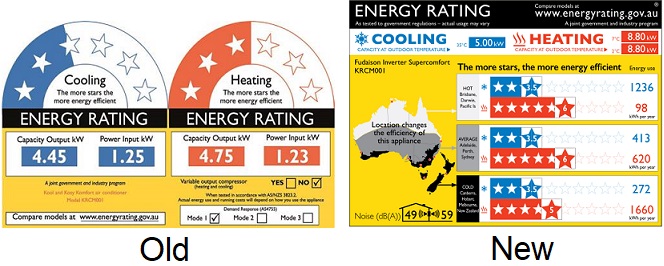
The new labels will eventually be required for all residential-sized split system air conditioners. These have an indoor wall unit and an outdoor compressor unit. Window mounted units will also need them. Large ducted air conditioners aren’t required to have the new labels, but manufacturers are permitted to obtain and display them.
The majority of air conditioners are reverse cycle and will have stars for both cooling and heating, but some units can only cool and will have no energy stars for heating.
What This Article Covers
In this article, I’ll tell you:
- Why air conditioners are efficient at heating and cooling.
- How your local climate affects their performance.
- How to use the new labels to choose a cheap-to-run air conditioner.
But if you want to get it straight from the horse’s mouth, the Department of Energy and the Environment has a 14 page brochure. If you just want a quick explanation of the new labels, there is also a two page guide.
Moving Heat Is Better Than Creating It
Air conditioners are heat pumps. Now I’ve told you this, it shouldn’t come as a surprise to learn they work by pumping heat around. In summer they pump heat out of homes and in winter they pump it in. One kilowatt-hour of electricity spent pumping heat into your home can provide several times as much heat energy as using one kilowatt-hour of electricity to generate heat with electric resistance heating.
Electric resistance heaters come in several types:
- Little space heaters with a heating element and fan inside which blows hot air.
- Oil-filled radiators.
- Bar heaters with a visible element that glows orange. (If it ever glows white — run.)
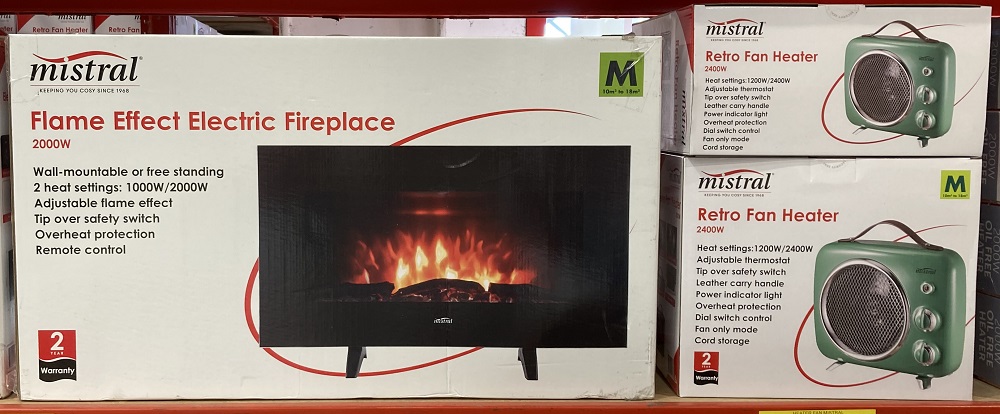
Electric resistance heaters also come in flat versions I try to watch TV on when I’m drunk1 and Hipster bait.
Electric resistance heaters are 100% efficient at turning electrical energy into heat. Making heat is actually the only thing we can do with 100% efficiency. Because nothing can be more than 100% efficient without being a perpetual motion machine, you may be wondering how a heat pump can be even more efficient.
Well, technically they’re not. They’re less than 100% efficient at moving heat around, but you end up with a lot more heat by using energy to move it around rather than using the same energy to create the heat directly. An electrical resistance heater can turn one kilowatt-hour of electrical energy into one kilowatt-hour of heat, but a heat pump can use one kilowatt-hour of electricity to move three or more kilowatt-hours of heat into your home.
The same thing happens when an air conditioner is used for cooling. It just goes the other way and moves the heat out of the house.
Improving Air Conditioner Efficiency
The average efficiency of air conditioners has been improving thanks to energy efficiency standards introduced here and overseas. The free market wasn’t able to rapidly boost efficiency levels by itself because people have a bad habit of not considering operating costs when buying things. Left to itself, the market also doesn’t take into account the benefit of reducing strain on the grid by lowering peak electricity demand on very hot or very cold days, or the benefit to the environment of reducing fossil fuel consumption.
The graph below shows how many kilowatt-hours of heat air conditioners tested from 2000 to 2014 will move out of your home per kilowatt-hour of electricity consumed:
While the graph is badly out of date, it does show efficiency has been improving. You can also see even the worst air conditioner, tested back in 2000, moves twice as much heat energy as it consumes in electrical energy. The most efficient air conditioner on the graph was tested in 2013 and could shift 5.8 kilowatt-hours of heat for every kilowatt-hour of electricity consumed.
The majority of home air conditioners for sale are reverse-cycle, which means they can both heat and cool. I can’t recommend getting an air conditioner that isn’t reverse cycle unless you live in Darwin where the lowest temperature reached last year was 16 degrees. Of course, if you’re in Darwin and felt like you were freezing to death when the temperature plummeted to 16 degrees and the gallium in your thermometer froze solid, then you should get a reverse cycle air conditioner.
Aircon Efficiency & Air Temperature
An air conditioner used for heating can still move heat into your home even if the air temperature is below zero. This is because air at zero °C still has 93% of the heat energy it has at 20 °C. It won’t have zero heat until it hits -273.15 °C.
But air conditioners aren’t going to work when it’s a couple of hundred degrees below zero. Their effectiveness drops as the air temperature gets lower. Ones designed for cold weather conditions can be more efficient than electrical resistance heating down to -30 °C. In Australia, the air doesn’t get that cold. Australia’s record low temperature was -23 °C in the Snowy Mountains and the lowest in any capital was -10 °C in Canberra.
This means air conditioners, which are air sourced heat pumps, remain an energy-efficient method of heating in the coldest Australian weather. In countries where it does get too cold for air source heat pumps to work, they get around the problem by burying the air conditioner coils underground. This is rarely done in Australia because it adds thousands to the cost of installation for only a modest increase in efficiency.
How Air Conditioners Work
Air conditioners have a fluid2 inside called “refrigerant” or just “working fluid”. Thirty-five years ago, if this air conditioner juice was let loose it would chew a hole in the ozone layer. But the world came together and agreed to phase them out for the good of the planet. (See? It can be done.) While the working fluid these days is less environmentally destructive, it can still be flammable, so remember to never smoke while stabbing your air conditioner.
When heating your home, the working fluid in the outside part of a split system air conditioner starts off as a liquid and boils or evaporates into a gas. When a liquid changes from a liquid to a gas it absorbs a lot of heat and this comes from the outside air, even if it’s cold by Australian standards. Before entering the indoors section, the gas is compressed into a liquid. The heat energy in the gas is concentrated into a small area and — because the amount of heat energy stays the same while its volume decreases — its temperature goes up. Because it’s hot, the heat energy can be blown into your home and then the cycle repeats.
Factors Affecting Efficiency
A number of factors affect how efficiently air conditioners operate. Some are more efficient at peak output while others do better when running at low power. How well they remove humidity from the air also affects efficiency as people feel cooler in dry air. But in cold climates, the most important factor is usually how efficiently the air conditioner deals with defrost cycles.
When the air temperature falls below 5.5 °C ice will start to form on an air conditioner’s outside coils. Defrosting them requires energy and some units handle this more efficiently than others. In hot climates, air conditioners will rarely have to run a defrost cycle, but in places such as Melbourne and Canberra, it’s very common and can have a large effect on efficiency.
Old Energy Efficiency Label (ERL)
The old Energy Rating Label (ERL) looked like this:
While not as good as the new ones it still gives useful information. They show how much electrical power is drawn under “Power Input kW” at high output and how much heating or cooling it provides under “Capacity Output kW”. If I was considering buying this air conditioner I would divide the Capacity Output by the Power Input to work out its efficiency. This would give:
- Cooling: 1 kilowatt-hour of electricity will move 3.56 kilowatt-hours of heat out of a home.
- Heating: 1 kilowatt-hour of electricity will move 3.86 kilowatt-hours of heat into a home.
But most people aren’t going to do this. They are just going to look at how many stars it has. The problem with this is, air conditioner efficiency can vary considerably depending on the local climate, and the old labels don’t don’t take this into account. The new ones were designed specifically to deal with this issue.
Zoned Energy Efficiency Label
Here’s what the new Zoned Energy Rating Label or ZERL looks like. This is an actual photo I took in a store, which is just one example of how I provide you with hard-hitting realism:
As you can see, the new label is a lot busier than the old one. This is mostly due to the addition of climate zones, although there are other improvements. While it looks a lot more complex, it’s not too bad as you only need to worry about information for the climate zone you are in.
Label Header
The label starts off simply by telling you what it is and giving a link where you can get more information:
I think the website it points you to could be better. It needs a tool allowing you to enter your location, the air conditioner you’re considering and its price, and spits out the total cost of ownership over 10 years.
But whenever I suggest something along those lines I get worried some executive will see it and spend hundreds of thousands of dollars to get that function when it should cost peanuts. Maybe several tonnes of peanuts, but that’s still not hundreds of thousands of dollars. (Peanuts are about $2,000 a tonne — as anyone from Kingaroy could tell you.)
Cooling And Heating Capacity
Below the heading is the cooling and heating capacity:
This is not efficiency information. It’s to let you see if its output is enough to either cool or heat the area you’re installing it in. There are sites which can help determine what size are conditioner you need, such as this page by CHOICE, and checking them out can give an idea of how much capacity you’ll need.
Getting one approximately the right size for the interior space and local climate is important. This is because if it’s…
- Too small — It will run flat out a lot of the time, which can be energy inefficient and it may not be able to raise the temperature as high, or decrease it as low, as you’d like.
- Just right — It should run efficiently and you won’t have wasted money by buying an air conditioner larger than you need.
- Too large — You’ve probably wasted money by getting a unit larger than you require. If it’s a little too large this shouldn’t affect efficiency, but if it’s much too large it may heat or cool in short bursts and rarely operate at its most efficient level.
The new label has one figure for cooling when the outside air temperature is 35 degrees. But there are two figures for heating — one for an outside temperature of 7 degrees and one for 2 degrees. The main reason there are two figures is because below 5.5 degrees ice starts forming on an air conditioner’s outside coils and the required defrosting cycles can cause a considerable reduction in heating capacity. An air conditioner that does poorly at 2 degrees compared to 7 degrees may be fine in Brisbane where it rarely gets very cold, but a poor choice for in a place like Hobart.
Climate Zone Map
On the left side of the label, there is a map of Australia divided into three climate zones. Here’s a version that’s a little clearer than the one in my photo:
As you can see, at some point New Zealand snuggled up a lot closer to Australia than it used to be. But that’s understandable. Who wouldn’t be attracted to us?
While New Zealand’s South Island is a degree or two colder than their North Island, they’ve clearly decided it’s not worth the effort of dividing their country into the separate zones of “Cold” and “Cold enough to freeze the crown jewels off a brass coat of arms.”

The NZ Coat of Arms commemorates the time the people of New Zealand came together as one to find out who stole their ugg boots.
Each zone is based on a climate in a reference location:
- Hot: Rockhampton
- Average: Richmond, Sydney.
- Cold: Canberra
When air conditioner performance is tested they are subjected to conditions simulating the climate of each of these three locations. (But not all at once.) This is how the energy star ratings for the three climate zones are determined.
Star Ratings
Most of the space on the new labels is taken up by energy efficiency stars. These show how efficient the air conditioner is at cooling and heating in hot, average, and cold climates:
The more stars the air conditioner has, the better. The unit in the example above is clearly less efficient at heating than cooling and I wouldn’t recommend it for Canberra. The fact it drops from 3 stars for warming in the hot climate zone to only 2 in the cold climate zone suggests it doesn’t handle very cold temperatures well.
Determining Aircon Operating Costs
Here’s the government’s 4-step guide to using the energy efficiency information:
It seems pretty easy when they put it like that.
To work out how much money it will cost you to run the air conditioner over a year — step 4 above — you add the energy use figures for cooling and heating to get the number of kilowatt-hours it is expected to use in a year and multiply the amount by how much your electricity costs. If you live in Brisbane, you’d look at the figures for the hot climate zone and add them together like this:
If you only use grid electricity with a flat tariff then it’s easy to multiply the total annual kilowatt-hours by what you pay for electricity to get the total operating cost. If you pay 20 cents per kilowatt-hour for electricity, then with the above example a typical household would pay $379 a year to run the air conditioner.
If you have solar panels — something I definitely recommend having — it becomes a little trickier. With the following assumptions:
- 20 cents per kilowatt-hour for grid electricity.
- 10 cents solar feed-in tariff.
- Half the electricity consumed is solar electricity.
Then the average cost would be 15 cents per kilowatt-hour and the air conditioner would cost $284 a year to run. It’s important to include the feed-in tariff you miss out on as a cost because otherwise it would go towards reducing your electricity bill.
If you have a time-of-use tariff, things become more complex and you may have to make a rough guess as to how much the average kilowatt-hour used by your air conditioner will cost you.
Note the figures you’ll get are for typical use in the reference location. If you know your air conditioner use is likely to be unusual, for example if you hate the cold but love the heat, or leave it running all year, or you’ve installed it in a tent — then you’ll have to adjust your estimate as best you can.
Up To 10 Stars
The maximum number of energy stars an air conditioner can have for cooling or heating is 10. The most received by any air conditioner tested so far is 8 for cooling. This leaves two unused stars for possible future improvements in efficiency.
The more stars, the more heat energy will be pumped out of your home when cooling — or into your home when heating — per kilowatt-hour of electricity, as shown by the following examples:
- 1 Star: The air conditioner pumps 2.5 to 3 kilowatt-hours of heat per kilowatt-hour of electricity consumed.
- 2 Stars: The air conditioner pumps 3 to 4.5 kilowatt-hours of heat per kilowatt-hour of electricity consumed.
- 3 Stars: The air conditioner pumps 4.5 to 5 kilowatt-hours of heat per kilowatt-hour of electricity consumed.
Going by this progression, a hypothetical, future, air conditioner with a 10 star rating could pump an impressive 7 to 7.5 kilowatt-hours of heat per kilowatt-hour of electricity.
Air Conditioner Noise
The final part of the new label gives the noise level of the air conditioner in decibels for both the inside wall unit and the outside compressor unit:
While it’s useful to give the decibel levels, this part of the label needs to be improved because very few people have any idea what decibels are. The government guide to the new labels gives the following examples:
It would be very easy to add these descriptions, or something similar to the labels. Most people don’t have a clue what “64 decibels” mean, but if they instead read…
- 64 Decibels — Noise volume of a typical conversation.
…then they’ll realize this particular air conditioner isn’t very quiet.
Advertising Stars
While each newly tested air conditioner must come with a full label, smaller and simpler versions can be used online or in printed advertising. They look like this:
An Appreciated Improvement
Air conditioners are responsible for increasing the cost of electricity due to the strain they put on the grid. Rooftop solar power has helped reduce this strain, but for some reason, this benefit is never acknowledged by our current federal government.
Without the improvement in efficiency driven by regulation over the past 18 years, air conditioner use would have pushed electricity prices even higher. Anything that helps people select more energy-efficient appliances, such as the new air conditioner labels, is appreciated.
If you have an old inefficient air conditioner — or even a new inefficient one — replacing it with a unit with just a couple more energy stars can potentially save hundreds of dollars a year. While it may seem wasteful to replace an air conditioner still in working order, you may find you are financially better off with something more energy-efficient. It can be good for your bank balance and good for the planet.
On the other hand, what could be even better for the planet and save you even more money is keeping your old air conditioner for now and putting the money towards a large new solar system for your roof. You can use our Solar & Battery Calculator to estimate how much you can save. While saving energy by getting a more efficient air conditioner is good, making energy can be even better. But, provided your budget stretches far enough, I suggest both.

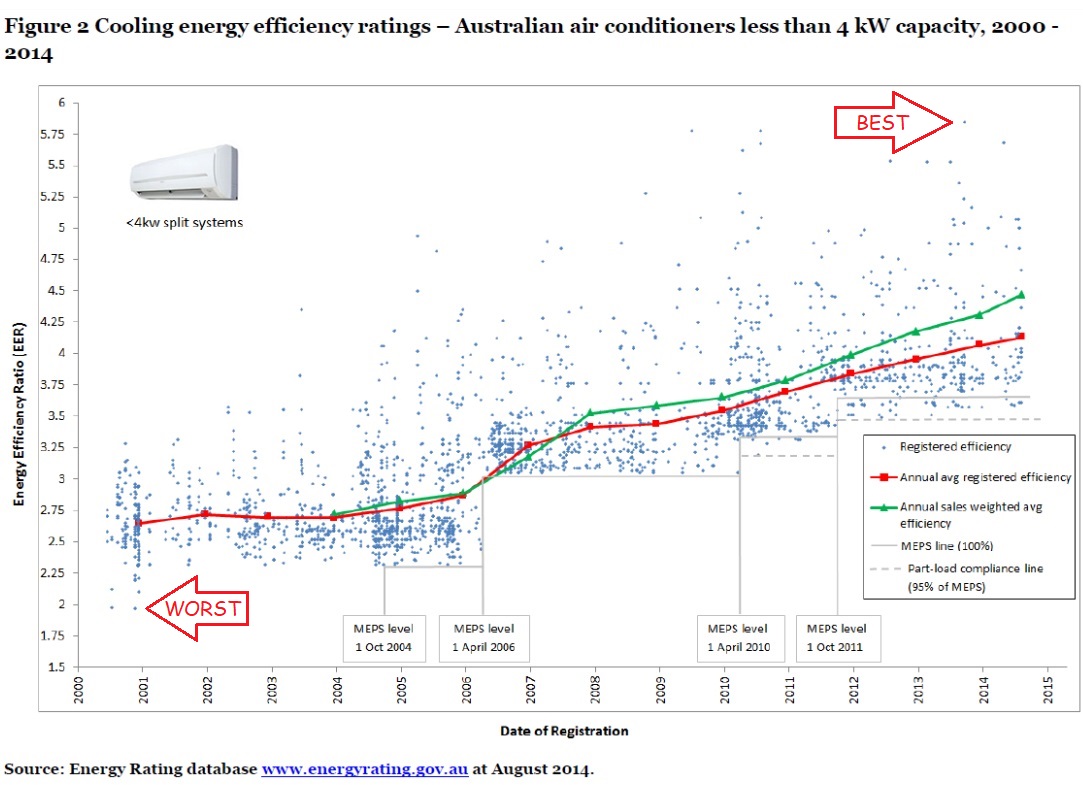
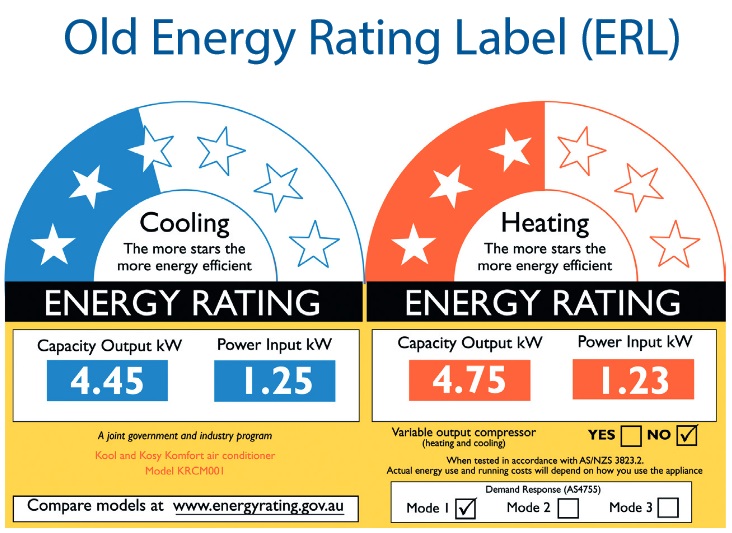
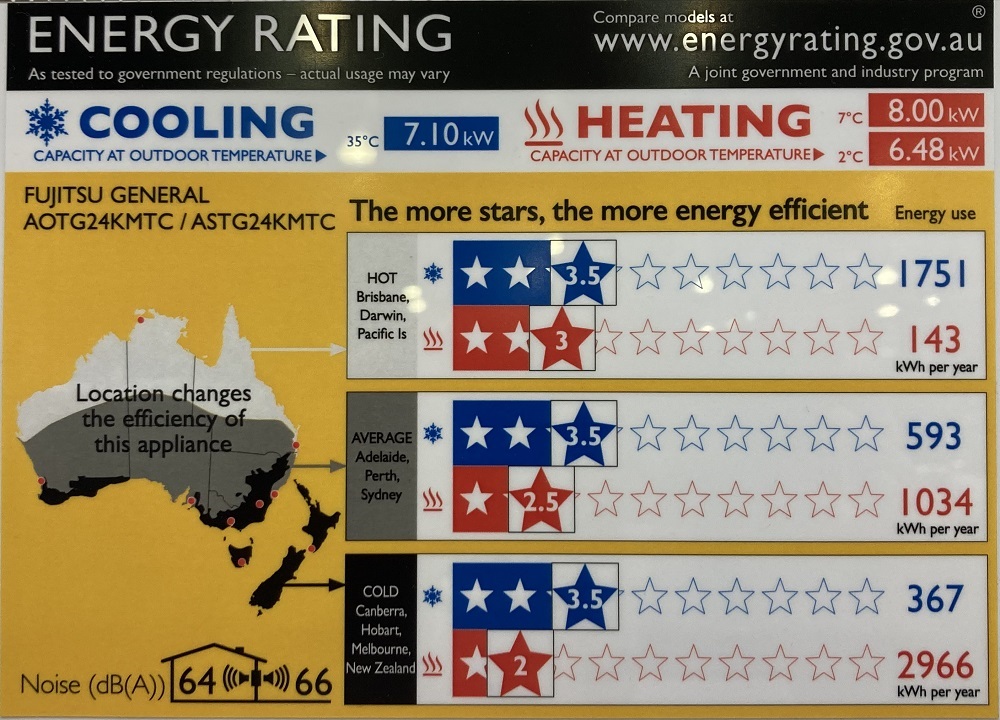


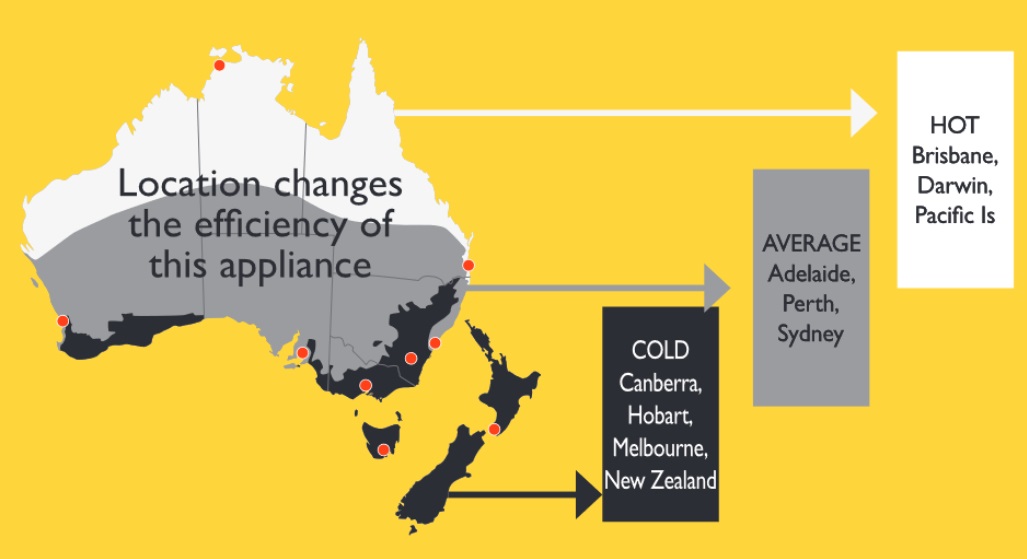
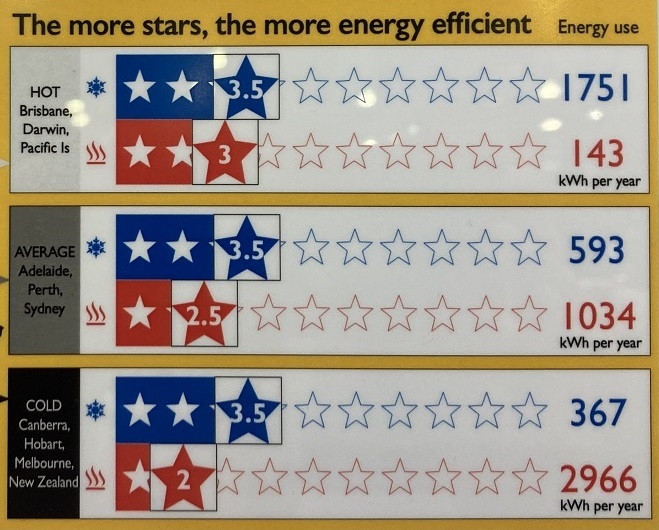
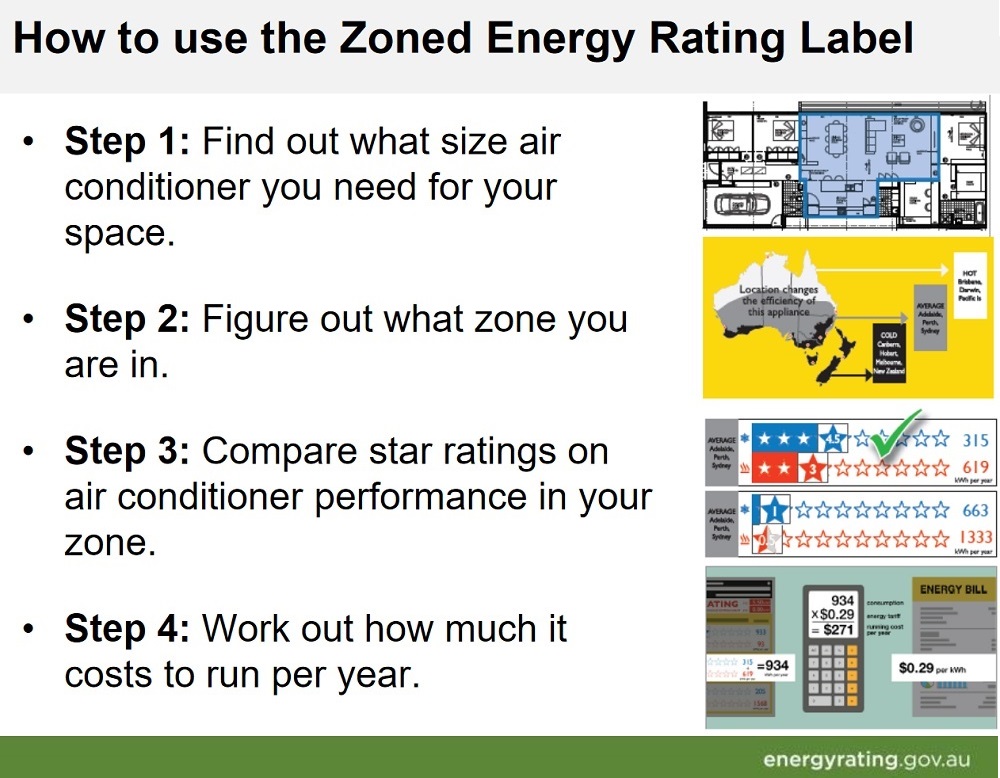


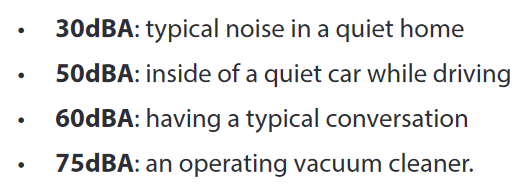

 RSS - Posts
RSS - Posts



Just to complicate things – the refrigerants in air-conditioners, even if the A/C says “Uses Ozone Friendly Refrigerant” – it is probably a fluorocarbon refrigerant – which are incredibly potent greenhouse gases (CO2e’s in the thousands). Unfortunately accidents do happen (renovations, leaks etc), and these gases get released into the atmosphere.
Unfortunately, (and not unexpectedly), the fluorocarbon industry has fought a very determined rear-guard action against the use of hydrocarbon refrigerants – which have extremely low CO2e – and are very cheap – whereas fluorocarbon refrigerants are expensive (and profitable).
So do ensure, that the refrigerant in your A/C isn’t fluorocarbon –
https://www.engas.com.au/products/
https://refrigerationclub.com/r290-and-r600a/
Hugh I will take that one step further for you. There is a big push in Europe now to ditch the HFC and HFO idea altogether and skip straight to Natural Refrigerants such a Propane and Isobutane: they are safer for our health.
There is a growing body of evidence that HFOs are just a dressed up version of HFCs: they break down in the atmosphere to form TFAs. Read this article and tell me if you want more of these in the air that you breathe. There is a persistent rise in TFAs near car plants in Germany, measured in the lakes and rivers near these plants. And the reports make for alarming reading.
https://en.refolution.de/hfo-report
As such, the EC look like they are going to be banning these in the near future.
https://www.coolingpost.com/world-news/ec-backs-adoption-of-propane-in-small-split-air-conditioners/
Interesting comparison but i imagine most people only use electric heaters for short term use.
What is the comparison of reverse cycle Vs gas ducted heating?
Modern air conditioners come out ahead. I intend to do an article in the future comparing the cost of using natural gas to using an air conditioner in all capitals. I guess I should get that done before the weather starts turning warmer.
A comparison would be nice, thanks.
I recently had my gas central heating fail and it took two weeks for repairs. So i used the rev cycle split system A/C.
It’s ok but not as good as the ducted gas heating which heats all rooms while typically i imagine, most people who install A/C like me, have a unit on one room only. The main living room. kitchen area.
My A/C is an 8kW cooling, 9kW heating unit.
I’ll have to make some time to get it done. I said I’d compare using gas with using an air conditioner for heating in all capitals SO I GUESS I SHOULD START PRACTICING NOW.
Glenn,
You ask: “What is the comparison of reverse cycle Vs gas ducted heating?”
Renew did a study published in Nov 2014 titled “Are we still Cooking with Gas?”
https://renew.org.au/wp-content/projects/CAP_Gas_Research_Final_Report_251114_v2.0.pdf
Tim Forcey, an energy advisor, researcher and author, wrote an explainer published on 28 May 2021 at RenewEconomy titled “Explainer: What’s the cheapest way to heat my house if I get off gas?”.
https://reneweconomy.com.au/explainer-whats-the-cheapest-way-to-heat-my-house-if-i-get-off-gas/
Even AGL states on its website:
“Over half of Australians* still rely on gas as a source of energy, but few realise that there’s a more cost-effective, energy-efficient option – heat pumps.”
https://discover.agl.com.au/your-home/heat-pumps-why-are-they-more-efficient/
A while back I researched A/C units and found some interesting things:
1. Larger A/C units are mostly LESS efficient (more kW used per kW moved, as you put it) than smaller ones.
2. Multiple smaller units can be more efficient BUT maintenance and installation costs go up because you have more of them.
3. Multiple smaller units can be good for ‘redundancy’ meaning a unit failure doesn’t leave you totally without A/C.
4. Daikin were noticeably more efficient than other manufacturers (why I have no idea).
So I bought 5 smaller units (two in the main room) and insulated the house REALLY well. They run on an off-grid solar / battery system (20kWp / 40kWHr if you are interested) and the extra efficiency was vital in keeping the battery cost down. The house is super thermally efficient (the roof was the most important to reduce solar gain – but then I also covered it with solar panels!). I measure 50-60deg Celsius up there.
A/C Efficiency matters unless you have lots of solar and don’t run at night.
The difference was significant.
Daikin D Smart King split type units:
2.5kW cooling COP = 4.81 (Watts out for Watts in)
3.5kW cooling COP = 3.89
5.2kW cooling COP = 4.19
7.2kW cooling COP = 3.95
10.5kW cooling COP = 3.14
COP = Coefficient of Performance
You can see that the 2.5kW units are about 20% more efficient and that reduced battery capacity needed.
As a total ‘aside’ I also checked the units during installation and they did not have anything to keep out lizards / insects from the invertors. That is a HATE of mine. I carefully wrapped the inverter boxes in a net to allow airflow but close off the many gaps to wildlife and hopefully that will stop expensive board failures which seem rife on modern A/C units.
If you look closely, you’ll see that efficiency improves with physically larger units and decreases with higher hearing/cooling capacity is the same physical size. 3,5kw will be the same physical size as a 2.5 kw which is why efficiency falls from a cop of 4.82 to 3.89 as you move from 2.5 to 3.5.
The 5.2kw unit is physically larger which allows it to be more efficient than the 3.5kw. But this also means more space is required and higher prices due to more going into it.
I assume that if you run a 3.5kw unit at only 2.5kw or less then it should be just as efficient as the 2.5kw, it it is hard to find anything definitive to confirm that though.
So many variables… Temperature differential, air moisture content, both inside and out, make a big difference. Operation time, radiant energy on the outside unit (whether the sun is shining directly on the unit, summer OR winter.)
Lots to consider.
Just a point re the defrost cycle on reverse cycle A/C units.
Here in Canberra my A/C will feeeze up about 20 mins after starting, on a cold evening. Outside temp about 2 to 5 degrees. The cycle can take minutes.
meanwhile you and your dinner guests are COLD.
A/C units differ in the way they acheive defrosting, but they all generally reverse the reverse cycle, and skow the internal fan down to a point where the cold air coming out of the internal unit is not noticed…
I am talking here about split systems. I don’t know how ducted heat pummp systems cope. Maybe they use a resistance heater? (Hope not…)
When you do your gas vs A/C heating, can you incorporate time-of-use electricity rates? Reason I ask is because most A/C units used as heaters are switched on when folks get home from work, ie 5PM. So they are using the most power (to get the house warm) during the peak rate.
When my solar hot water system packed it in, I was advised by everyone, even the electrician who installs solar systems, to get a gas hot water system, despite me being on bottled gas. I really wanted a heat pump. Only one place in town had a brochure on one, and it’s rating didn’t even hit 0degrees, and we get minus6 frosts. So I gave up. Its really hard as a single woman to wade through the info and actually source products which are not readily available, let alone have someone competent to install them.
Sharyn,
You state: “When my solar hot water system packed it in, I was advised by everyone, even the electrician who installs solar systems, to get a gas hot water system, despite me being on bottled gas.”
I’d suggest ‘they’ would, because ‘they’ usually don’t deal with these types of systems. Unfortunately, it seems if people don’t deal with or are not familiar with heat-pump hot water systems, then it’s likely they will try to steer you towards what they know and what they can SELL to you.
The other problem is people usually don’t think about their hot water systems until it fails, and then there is an urgency to fix it quickly or not have hot water. That usually means fixing it quickly with like-for-like.
My house originally had a gas-fired pilot-lit hot water storage tank system, that was from memory about 17+ years old, that was showing rust in the water. I replaced it before it failed, and now have a Sanden Eco® Plus Hot Water Heat Pump System.
Where I live, winter temperatures usually get down to -5 to -7 °C (and in some instances recently as low as -12 °C) overnight. Occasionally there is snow. Maximum winter daytime temps can be only +5 °C.
When freezing conditions occur, the heat-pump unit will run briefly to heat the water in the insulated recirculation pipes between it and the storage tank to prevent freezing. The unit can be programmed to heat water during the day to take advantage of solar-PV or when electricity is cheapest.
See: https://www.sanden-hot-water.com.au/how-a-sanden-heat-pump-system-works
As far as I’m aware, Sanden is available only through their accredited installer/dealer network. If you wish, enter your postcode to find an installer/dealer near you at (right-hand side of): https://www.sanden-hot-water.com.au/contact-us
You may also wish to check out Renew magazine for heat-pump hot water solutions, etc.
https://renew.org.au/resources/how-we-can-help/efficient-electric-homes/how-we-can-help-heat-pump-hot-water-systems/
Thanks for the article.
You state: “On the other hand, what could be even better for the planet and save you even more money is keeping your old air conditioner for now and putting the money towards a large new solar system for your roof.”
You forgot to mention energy efficiency measures
– first: stop draught
– second: insulate
– then install solar
In other words – first reduce the cooling/heating demand and then install solar and a smaller aircon.
Humanity won’t solve the climate problem if we always forget energy efficiency measures.
Well, it’s Australia, so I’d say arrange solar first and just don’t turn your air conditioner on. Then you can take care of the thermal envelop of your home and then turn that heat pump on. (Admittedly, it can be hard to resist turning on the air conditioner in the middle of summer. Also potentially fatal these days.)